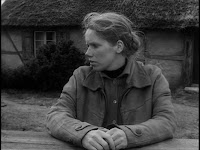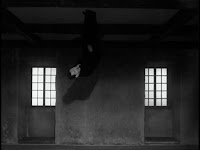In 1968 Ingmar Bergman released what was his first and only horror film – known domestically as Vargtimmen and in the US/UK as Hour of the Wolf. Now you may be thinking, Bergman… vampire film… never heard of such a thing and I must admit I hadn’t but then it started flickering on the edge of my radar.
I do a variety of searches round the net looking for obscure vampire titles and this came up in one such search. I found a couple of articles that mentioned vampires and vampiric ghosts in connection with this and one lone comment on IMDb struck me as a commentator, MisterWhiplash, headed his comment “A Bergman vampire movie, but without any vampires- pure, Gothic chills”.
I decided, therefore, to explore the film – which had the working title (as it was written) of The Cannibals.
The film begins with a legend that explains that some years ago the painter Johan Borg (Max Von Sydow) vanished without a trace whilst on the Frisian Island of Baltrum. His wife Alma (Liv Ullman, Leonor) gave *me* (presumably Bergman or an unnamed fictional director, during the opening we can hear the sounds of a movie sound stage being worked upon until the director calls all to order and the film begins) his diary and between that and interviews with Alma the film was born. We see her emerge from a cottage on the island – she seems reluctant to talk further to the camera but eventually mentions the fact that she is now eight months pregnant and then begins to explain how she and Johan arrived there that year.
We see them arrive and Johan push their things up to the cottage on a wheelbarrow. They go to the island each year so that he can paint and escape people. We do not see, but hear from Alma that when they arrived they found footprints in the flowerbed beneath the kitchen. At first things seem idyllic, despite this. Johan sketches Alma and they seem a happy couple. This façade cracks quickly and we see quickly that Johan is a tortured artist.
It is night and Alma is clearly uncomfortable as Johan paces. He suddenly pulls out a sketchbook and tells her that he has sketched *them*. When Johan’s art is referred to we never see the art ourselves. He explains that the first one is common and harmless, he thinks he is homosexual. The next is an old lady, always threatening to remove her hat and then her face. The worst of them all is the birdman, Johan doesn’t know if the beak is real or a mask but he is Papageno (the character from the Magic Flute who represents error, the Magic Flute is referenced again later and Bergman famously directed a filmic version of the opera). What are these things (he lists more of them)? Personal demons, actual demons, ghosts? Johan cannot sleep, he feels, until it is light but then falls asleep and is helped to bed.
The next day, as Johan goes to paint, Alma is doing housework when a woman appears at the cottage – she is the Old Lady with Hat (Naima Wifstrand), as Johan described, and Alma can see and converse with her. She tells Alma that she is 216 years old and then corrects that to 76. She then tells Alma that under the bed is a black satchel containing the sketches that Johan made of her and the others – she must not let him destroy them – and his diary. She advices Alma to read it and she does.
The first entry, it appears, tells of Johan, having recently been ill, being approached by Baron von Merkens (Erland Josephson) – the owner of the island – who invites him to dinner at the castle. The next entry tells of meeting his previous lover Veronica Volger (Ingrid Thulin). She tells him he must be more careful as her breast is bruised and then she reveals that she has received a letter that warns her – of what is unclear but we assume her affair with Johan. We see Johan pace towards the cottage and a man follows with laboured breaths. He identifies himself as the Therapist Heerbrand (Ulf Johansson) and he so annoys Johan that he punches the man. When he gets to the cottage he and Alma settle down to eat (she quickly hides his diary) and she mentions that she needs money. He places notes on the table but she wants to detail the household accounts – something he seems uninterested in. When he tells her they have been invited to the castle she already knows – there seems to be a non-linear aspect to the diary entries because of this.
At the castle they are introduced to Corinne (Gertrud Fridh) wife of the Baron, the Countess (Gudrun Brost) the Baron’s mother, Ernst (Bertil Anderberg) the Baron’s brother, Heerbrand and an archivist named Lindhorst (Georg Rydeberg). It is astounding how much Rydeberg looks like Bela Lugosi – but that a vampire does not make! It is entirely possible that these people are part of Johan and Alma’s psychosis (as they now seem to share a psychosis) or something else. The dinner party is oppressive, the use of sound astounding making the viewer tense – picked out in conversation is the line “We still have our fangs.” The Baron and Corinne claim to know Veronica – they have the portrait of her that Johan painted and later the Baron suggests she is his mistress. Alma is aware that they were together for five years and later we find out that their tempestuous relationship was not only a scandalous affair but had elements tantamount to stalking and Johan ended up hospitalised (presumably in a psychiatric hospital).
After the dinner there is a puppet show and the tiny puppet (Folke Sundquist) actually appears to be alive, singing the Tamino part of the magic Flute, an extract from Act 1 scene 2 where Tamino sings of eternal night. Alma and Johan are becoming fraught. If we look to his previous passionate affair, and then note that Alma believes he rarely even kisses her we wonder at their relationship. We hear that Alma believes that they – the castle denizens – want to control him. I could continue waxing lyrical about this astonishing film but I want to concentrate on three parts that are relevant to the “Vamp or Not?”
In the Hour of the Wolf – a specific hour in the night – Johan tells Alma of the abusive punishment he suffered as a child and then confesses the truth regarding the day he claimed to suffer a snakebite. We see him on the rocks, fishing and painting and a young boy (Mikael Rundquist) in trunks suns himself, messes with his gear and seems almost flirtatious. The music becomes unbearable to us and Johan's frustrations grow. He says something inaudible and then attacks the boy, who tries to bite his neck and is crushed against a wall. On the floor he bites Johan's ankle. (Why would the bite even resemble a snakes? Surely the dentition would be human?) Johan bludgeons him and throws the body into the water. The sight of him seems to have been lifted, years later, by Ken Russell in the film Gothic.
Later, in the castle as the world turns upside down, we see many a sight. We see the Baron walking up a wall and hanging from the ceiling, we see the Old lady with Hat actually peel her face away and remove her eyes. It seems that Johan might already be amongst the dead as his colour is described as pallid and his lips blue before Lindhorst puts makeup on him and makes him wear a dressing gown before being shown to Veronica. Lindhorst reveals wings during this – is he the birdman?
When he finds Veronica – led out on a table and covered with a sheet as though she were a body in a morgue – Johan kisses her. When he looks up the smeared lipstick does look like blood and his eyes seem sunk into his skull. The various members of the household watch him mockingly, laughing at the spectacle he has become. He runs from the castle into the wilds.
His death is sudden and Alma (whom he thinks he has fatally shot) sees it. The household attack him, firstly the therapist strikes him and then the Countess slits his throat at the artery. Lindhorst at once man and bird pecks/strikes his temple. Then they fade into the background and Alma sees that no-one, including Johan, is there. He likely died but he truly vanished. Is it Vamp?
I’d love to say yes. This is an astonishing film, with wonderful cinematography as one would expect. It is a revelation, a many layered spectacle for those with the desire to delve into its mysteries and things do remain mysterious. However, despite some elements it is NOT VAMP. I watched it looking for those elements and so they seemed more obvious (perhaps I looked at them as potentially vampire related because I wanted it to be so). All in all, I do not know what the household etc were but, being honest with myself, there is nothing that makes them particularly vampiric in essence. They are his personal demons made flesh, perhaps, or even they are Alma’s – as is Johan. However, you could do a lot worst than settle down to watch this multi-layered masterpiece. The imdb page is here.
Saturday, July 31, 2010
Subscribe to:
Post Comments (Atom)




























4 comments:
An intriguing review (btw, something is in the mail for you...)
Zahir, this is one I think you'd get a lot out of (if you haven't seen already). Not vampire but jaw droppingly beautiful and disturbing - proving (if it needs proving) why Bergman was one of the fibnest directors ever.
A masterpiece. The commentator on the disc seems to think it's "vamp"
as he mentions vampires on several occasions but I don't see it either. This is not "vamp". Demons, ghosts, serpents, whatever,
but not vamp. Nevertheless a fantastic psychological horror. If you want to see what a Bergman vampire-influenced film might have looked like (even tho' it would fit in vamp or not cat.?) I recommend searching out Leslie Stevens' INCUBUS (1965).
I actually have that (Incubus) in my too watch pile - a pile that is embarassingly large tbh.
However, I must confess that beyond anything else, I picked it up because of Shatner in Esperanto, lol...
Post a Comment